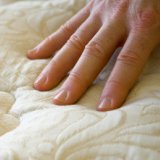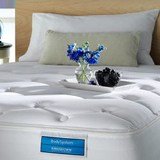Allergy Mattress Covers
Tips for Finding the Best Hypoallergenic Bedding
People who suffer from allergies to dust mites, bed bugs and airborne allergens in general find that allergy mattress covers and pillow covers seem to help alleviate their symptoms and help them get a more solid nights' sleep. Which types of allergy covers work best?
Why Use a Mattress Cover to Alleviate Allergies?
How does a mattress cover and other types of hypoallergenic bedding help with allergies?
Inside of every mattress, pillow, box spring and bedding piece live tiny little creatures called dust mites. Also lodged in our bed and bedding is dust, dust mite feces, dead dust mites, pet dander, dust, pollen, and even mold.
Yikes!! Just thinking about it is enough to make you lose sleep!!
Even worse, an infestation of bed bugs can also cause allergic reactions in some people. All of these contaminants cause allergic reactions such as red swollen eyes, uncontrolled sneezing, runny nose, and possibly sinus blockage.
A mattress cover designed especially for those with allergies will trap all of the allergy-causing contaminants and keep them from coming into direct contact with your body.
Think of a mattress cover like this - it's a nice, soothing layer of protection against dust mites, bed bugs, and allergens. The cover is simply slipped over your mattress and zipped up securely. Sheets and bedding go onto the bed directly over the cover, so you don't see or feel it.
Pore Size of Fabric - Measured in Microns
It's important to note that the pore size of the fabric used to make a mattress cover is significant. When shopping for a mattress cover geared toward people with allergies, pay attention to the pore size or microns of the fabric.
The reason is this: dust mites average about 10 microns in size and pet dander is about 3 microns in size, so depending on your allergies, you should look for an allergy cover that has a smaller micron size than the allergen you're trying to keep out of your mattress.
What Are Allergy Mattress Covers Made Of?
It varies from product to product, but you could find allergy covers and hypoallergenic bedding made from any one of the following materials:
- 100% cotton
- Organic cotton
- Cotton/poly blend
- Microfiber
- Polypropylene - People with glycol allergies would be sensitive to this type of cover.
- 100% polyester
- Waterproof membrane
Are Non-Toxic or Organic Mattress Covers More Effective?
The answer to this question depends on a few factors. First, if you are allergic to chemicals and toxins in fabrics, then yes, organic mattress covers that are manufactured from non-toxic materials are a must for you.
A second factor to consider is that some people say the organic cotton covers are more comfortable and softer than the others on the market, so if you are keenly aware of how a cover feels under your sheets, then organic may be the right choice for you.
Is an organic, non-toxic mattress cover more effective against allergens and tiny creatures? There doesn't seem to be a significant difference between the organic and non-organic products when it comes to keeping out dust mites, bed bugs, and allergens.
That said, it's important to note that consumers have reported their allergic reactions or symptoms were significantly reduced when they made the choice to use allergy mattress covers on their mattress and pillows.
Prices of Allergy Mattress Covers
The least expensive mattress cover you can find on the market is made from polypropylene and will cost you roughly $9.99 to $15.00.
All cotton mattress covers can cost between $29 and $100. The cotton and polyester blend covers average between $24 and $79.
The waterproof bed bug resistant mattress covers can cost $12 for a twin and up to $50 for a queen size cover. Microfiber covers are reasonably priced between $49 and $150.
Organic mattress covers will be the most expensive, beginning around $65 for a crib size and going up to $395 for a king size cover.
Brand and quality of the mattress cover in question will also determine the price point, so be sure to do your research before making your final decision.
Benefits of Allergy Mattress Covers
- Protection from allergens, dust mites, bed bugs, and other particulates
- Protects the mattress from moisture and stains
- Could provide additional cushioning on top of the mattress
- Breathe cleaner air while sleeping due to allergens, dust mites, etc. trapped safely inside the cover
- Cleaner sleeping environment overall
Drawbacks of Allergy Mattress Covers
- Polypropylene covers can be noisy and cause you to sweat during the night
- Organic cotton products can be cost prohibitive for some consumers
- Difficult to get onto a mattress without two people
What Materials Work Best?
People who suffer with allergies are some of the most willing consumers when it comes to sharing their experiences with products geared toward curbing or helping allergy symptoms. Consumers seem to like the breathable microfiber materials and the all-cotton fabric when it comes to allergy mattress covers.
These materials seem to curb their symptoms and they experience fewer, if any, allergic reactions during the night as a result of slipping a cover over their mattress.
Typically, allergy sufferers will cover their pillows as well, and perhaps use an allergy pillow, to ensure that they aren't getting allergens from the pillow or the mattress.
Tips for Buying the Right Allergy Cover
- Measure the depth or height of your mattress so you get the right size cover to fit
- Look for a certification symbol that indicates it's an allergy and asthma friendly product - products with this seal of approval have undergone intense testing to make sure it's a quality product worthy of helping allergy sufferers
- An allergy cover with a micron size of 2.8 is the best you can find on the market - this pore size will keep out nearly every contaminant, including bed bugs, dust mites, and pet dander
- Opt for a breathable fabric - it will be softer, more comfortable, and quieter
- Follow the cleaning instructions for your cover so that it will last a long time for you
Choosing just the right allergy mattress cover for your needs takes a little time to research, but the time invested is well worth the knowledge that you are well protected from the little creatures and allergens that reside in every mattress and pillow!
Let's All Sleep Better
Help us to spread the word!
Simply copy and paste this code into your Facebook page or blog. Thank you for sharing!



New! Comments
Share your thoughts about what you just read! Leave me a comment in the box below.